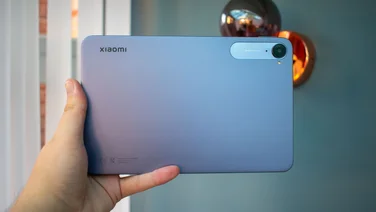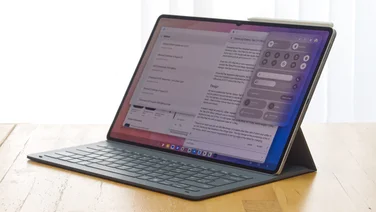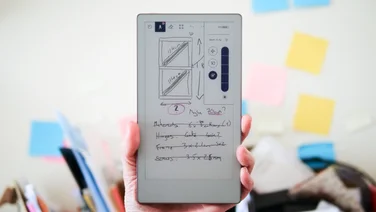To help us provide you with free impartial advice, we may earn a commission if you buy through links on our site. Learn more

The iPad Pro is finally out of the bag. With its large screen, detachable keyboard and fancy stylus (sorry, Pencil), it’s by far Apple’s most ambitious tablet to date, offering a huge digital canvas for budding creatives as well as a practical, portable two-in-one for mobile workers.
However, for all Apple’s talk of ‘desktop-class’ speeds and ‘barrier-breaking performance’, it’s not like we haven’t seen this all before, as Microsoft has been doing the same thing with Windows tablets ever since the first Surface Pro came out two years ago. So, how does the iPad Pro compare with the Surface Pro 3? I’ve been comparing its specs to find out, giving you an initial idea of how Apple’s brand-new slate stacks up against its biggest rival.
Looking for something a little smaller? Check out our list of best tablets for 2015
Unfortunately, no one has been able to benchmark the iPad Pro yet, or test the technical performance of its screen, but I’ll be updating this article over the coming months with all my test results as soon as I’ve had a chance to put it through its paces.
Design
Dimensions: Considering it’s such a large tablet, the iPad Pro is impressively slim. Lie it down flat on a table, for instance, and it will stand no higher than an iPhone 6. Measuring 306x221x6.9mm and weighing 713g for the Wi-Fi model and 723g for the cellular version, the iPad Pro is significantly thinner and lighter than its Microsoft rival.

The Surface Pro 3, on the other hand, is positively giant by comparison, measuring 292x201x9.1mm and weighing 800g. This is partly to make room for the full-sized USB3 port on the side of the tablet, but it’s still a substantial size difference when you lay it down next to an iPhone 6.
It does, however, have an adjustable kickstand which flips out of the rear of the tablet, allowing you to position it at any angle you like. The iPad Pro is freestanding, allowing it to cut down on size even further. However, it does mean you’ll have to buy one of Apple’s Smart Keyboards if you want to prop it up on a table, and even then you’re limited to two fixed angles (one for typing and one for watching, according to Apple), making the Surface Pro 3 the more flexible of the two devices despite its chunkier dimensions.

Materials: The iPad Pro shares the same aluminium chassis as its smaller siblings, so it’s bound to feel just as well made, and just as durable. The Surface Pro 3 also has a metal chassis, but uses vapour-magnesium instead. This is easily as attractive as previous iPads, and it’s certainly one of the best-looking tablets we’ve seen in the last year, so both devices should look and feel like they justify their respective prices.
Display
Screen size & Resolution: The iPad Pro has a massive 12.9in 2,732×2,048 resolution display, making it Apple’s biggest iPad to date. It’s also the most advanced Retina display it’s ever produced, as it can change it’s own refresh rate to suit whatever’s onscreen, helping to save battery. For instance, when the screen is static, it will cut the refresh rate from 60Hz down to 30Hz. When you start playing a game though, or working, the refresh rate jumps back up to 60Hz for smooth images.

However, its pixel density is actually nigh on identical to the iPad Air 2, coming in at 265ppi over the Air 2’s 264ppi. That might sound disappointing on paper, but it’s still higher than the Surface Pro 3, which has a smaller 12in display and a 2,160x,1440 resolution. This only gives the Surface Pro 3 a pixel density of just 216ppi, but it’s still incredibly sharp either way and I certainly didn’t notice any jagged edges during testing.
It’s also important to note that the Surface Pro 3 has a 3:2 aspect ratio rather than a 4:3 ratio like the iPad Pro. This means the screen is slightly longer, almost like an A4 sheet of paper, rather than the shorter, more box-like shape of the iPad Pro. In my eyes, 3:2 is much better for drawing on, it also means you will have smaller black bars on the side of the screen when watching typical 16:9 videos, plus it shares the same aspect ratio as 35mm camera film (although many cameras shoot at 4:3 too, so viewing photos is a mixed bag).

Screen technology: Apple has always used backlit-LED displays for its tablets, and the iPad Pro is no different. The Surface Pro 3 also uses an LCD-based display, but also has Microsoft’s ClearType technology to supposedly help improve text rendering.
Either way, the Surface Pro 3 had one of the most colour accurate displays I’ve seen on a tablet, beating even Apple’s 13in Macbook Pro when I tested it last year, so I’ll be pleasantly surprised if the iPad Pro can surpass it when we get one in for testing.
Performance
Processor & Graphics: As you’d expect from a top-end iPad, the Pro comes with Apple’s brand-new 64-bit A9X processor, which allegedly is 1.8x times faster than the iPad Air 2’s A8X chip. Apple has also said that its graphics performance is twice as fast as the iPad Air 2 as well, thanks to its new Metal programming language.

Whether it will be able to compete with the Surface Pro 3’s Intel chipsets is another matter, though, as the Surface Pro 3 uses the same fourth-generation Haswell-based Core chips as many of last year’s ultra-portable laptops. Of course, Haswell has since been replaced by Intel’s new Skylake architecture, but it still provides plenty of power for this Windows-based tablet, making it one of the most powerful slates currently available.
Battery: Apple claims the iPad Pro will be able to last for up to ten hours when surfing the web, watching videos or listening to music. The cellular version, on the other hand, is rated for nine hours of surfing the web when connected to a mobile data network. We’ll be putting these claims to the test when we get one in for review, but I’ll be surprised if its video playback time will be able to match the Surface Pro 3.
For instance, while Microsoft only rates the Surface Pro 3 for nine hours of web browsing, I was able to get an impressive 12h 46m in our continuous video playback test when the screen brightness was set to 50%, putting the ball firmly in Apple’s court here.
Keyboard
Like Microsoft’s Type Cover keyboard, Apple’s new Smart Keyboard snaps magnetically to the underside of the tablet and doesn’t require charging, allowing you to use it as soon as it’s attached. It’s also designed to fold flat against the tablet as a makeshift screen protector when it’s not in use. Unlike the Type Cover keyboard, though, Apple’s Smart Keyboard doesn’t lie completely flush to the iPad Pro’s screen, as the keys are designed to fold back underneath themselves, creating a small raised section as seen below.

However, the top layer has been made from a custom-woven fabric that’s been laser ablated to form the shape of each key, according to Apple. This allows each key to spring up and down when you type, eliminating the need for conventional mechanisms. It’s also water and stain resistant, so it hopefully shouldn’t break if you happen to spill anything on it. I can’t yet comment on what it’s like to type on, of course, but I’ll be updating this section in due course once I’ve had a chance to try it out for myself.
Microsoft’s Type Cover, on the other hand, is great for typing, and I particularly like how you can raise your typing angle by snapping the additional magnetic strip at the top of the keyboard to the lower bezel of the tablet. This brings a welcome sense of stability on more uneven surfaces, such as when you’re lying back on the sofa, and the extra height provided a fraction more tactile feedback as well. The Type Cover also has a touchpad as well, which is something Apple’s Smart Keyboard lacks.

Stylus VS Pencil
One of the iPad Pro’s biggest features is its sensitive touchscreen, which is designed to work hand in hand with Apple’s very own stylus, the Apple Pencil. Again, it’s difficult to say whether it’s better than Microsoft’s Surface Pen without having tried it out for myself, but considering how expensive it is, I’m hoping Apple has pulled out all the stops to make it the best digital stylus yet.
As you’d expect, the Apple Pencil is pressure sensitive, so it can tell the difference between lighter, thinner lines and more forceful, wider brushstrokes. It also has two tilt sensors built into the tip to calculate the exact orientation and angle of your hand, making it easy to change grip or position as and when you like when shading. This is one of the biggest issues I’ve had with other digital styli, so I’ll be very impressed indeed if Apple has managed to correct this huge flaw.

Microsoft’s Surface Pen is also pressure sensitive, and has palm-blocking technology so you can rest your hand on the screen. Apple didn’t make any mention of palm-rejection in its initial presentation, but judging by its own demo videos, it’s probably safe to assume it does. The Surface Pen also has two buttons on the side which you can assign various functions to, such as erase or undo, as well as a button on the rear of the pen which automatically opens OneNote with a single click, or captures a screenshot with a double-click. The former can be done even when the tablet’s in sleep mode, making it very easy to jot down a quick note without having to log in to your Microsoft account and open the program manually.
The Pencil doesn’t have any buttons, so it may end up being less practical than the Surface Pen in the long run, but this won’t really matter if it’s a better drawing tool overall. I’ll bring you my definitive verdict once we get one in for review.
Operating System
Of course, regardless of how well each one performs, one of the biggest reasons why you’ll opt for one tablet or the other will come down to which operating system you want to use. Naturally, the iPad Pro runs iOS 9, whereas the Surface Pro 3 ships with the full 64-bit version of Windows 8.1 Pro and comes with a free upgrade to Windows 10.
This means you can install any third-party program you like on the Surface Pro 3, as it offers the same flexibility as a traditional Windows laptop or PC. The iPad Pro, on the other hand, is limited to what’s in the App Store. There’s not to say the iPad Pro will be short of programs, though, as Microsoft even took to the stage at Apple’s launch event to demo how its mobile versions of Office could be used on the Apple’s new tablet, so it’s not like you’ll be straped for productivity tools if you opt for the iPad Pro.

In fact, iOS 9’s new multitasking abilities, such as Slide Over, Split View and Picture on Picture make it much more useful than iOS 8, as it’s now even easier to work across different apps and switch between them. iOS 9 also fits in well if you own other Apple devices, such as an iPhone or Mac. Continuity, for instance, lets you answer calls from your phone on either your iPad or Mac, while Handoff lets you starts tasks on one device and finish them on another.
Windows 10 has enchanced its multitasking capabilities as well, of course, and it’s now much better at switching between its tablet and desktop interfaces as well, allowing for a more seamless transition between work and play when you disconnect the keyboard.
Storage & Price
Apple still hasn’t confirmed UK prices for the iPad Pro, Apple Pencil or its new Smart Keyboard yet, but we can make an educated guess on how much they’ll cost by looking at the US prices. The 32GB iPad Pro, for instance, will cost $799, while the 128GB model costs $949. The cellular 128GB iPad Pro, meanwhile, costs $1,079. Once you’ve added on UK VAT, this works out to roughly £625 for the 32GB version, £740 for the 128GB version and £840 for the cellular model.
The Apple Pencil, meanwhile, costs $100, equating to roughly £80 inc VAT, while the Smart Keyboard costs $169, which is around £125 inc VAT.
The Microsoft Surface Pro 3, on the other hand, starts at £639 for the 64GB Intel Core i3 model, and quickly rises to £849 for the 128GB Core i5 model. Prices go up even further if you want one of the higher specifications, too, as the 256GB Core i5 model costs £1,079, the 256GB Core i7 version costs £1,299, and you’ll need an eye-watering £1,549 for top spec 512GB Core i7.
Microsoft’s Type Cover keyboard, meanwhile, costs £110. The Surface Pen also costs £45, but this is now bundled in with every model of the Surface Pro 3, so you don’t need to spend any extra to get a stylus.
Taken together, then, the Surface Pro 3 has the edge on price, as you’re getting double the amount of storage and a stylus for potentially only £15 more on the entry-level model. Likewise, the 128GB model may only cost £9 more than our estimated 128GB iPad Pro price, but you don’t have to pay any extra for the stylus, making it better value overall.
Conclusion
The Microsoft Surface Pro may be the better value tablet on paper, but judging from our initial specs comparison, it’s an incredibly close-run race. Both tablets have excellent build quality and their various accessories look to be of equally excellent calibre. With so much riding on the iPad Pro’s performance, battery life and screen quality, we’ll be paying close attention to how it fares when we get one in for testing, and we’ll update this article as soon as we have a final verdict.






